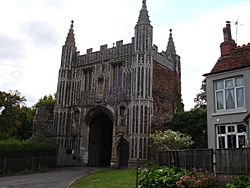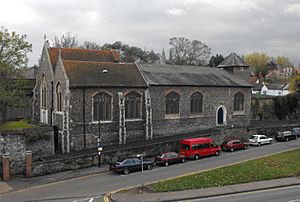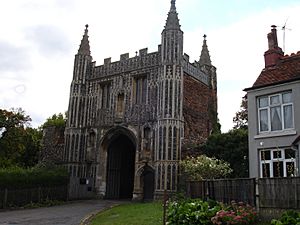St John's Abbey, Colchester facts for kids

Gatehouse of St John's Abbey
|
|
| Monastery information | |
|---|---|
| Other names | Colchester Abbey |
| Order | Order of St Benedict |
| Established | 1096 |
| Disestablished | 1539 |
| Dedicated to | St John the Baptist |
| Controlled churches | St Giles |
| People | |
| Founder(s) | Eudo Dapifer |
| Important associated figures | Thomas Marshall, John Howard, 1st Duke of Norfolk |
| Architecture | |
| Status | Dissolved |
| Functional Status | Largely demolished |
| Heritage designation | Grade I |
| Site | |
| Location | Colchester, Essex, United Kingdom |
| Coordinates | 51°53′7.96″N 0°54′5.67″E / 51.8855444°N 0.9015750°E |
| Visible remains | Abbey Gate, Precinct Wall, St Giles Church |
| Public access | yes |
St John's Abbey, also known as Colchester Abbey, was a large Benedictine monastery in Colchester, Essex, England. It was founded in 1095 and closed down in 1539 during the time of King Henry VIII. Today, only a few parts of the original abbey remain, like its impressive gatehouse.
Contents
History of St John's Abbey
How the Abbey Began
The place where St John's Abbey was built was once home to an old Saxon church. This church was dedicated to St John the Baptist or St John the Evangelist. People believed they could hear "miraculous voices" there. When archaeologists dug up the site in the 1970s, they found the Saxon church was made from old Roman building materials.
After the Norman conquest of England in 1066, a powerful Norman lord named Eudo Dapifer took control of Colchester. Eudo was a close friend of King William I and King William II. In 1095, Eudo said he saw a miracle at the old St John's Church. He used this as a reason to start a new Benedictine monastery there.
With the support of the Bishop of London, construction began in 1096. Eudo himself supposedly laid the first stone. The abbey was built using stones from the ruins of Roman Colchester. It took many years to build, finally finishing around 1115. At first, it was a "priory" because Eudo, being a normal person and not a church leader, couldn't officially start an "abbey."
After some challenges with monks leaving, Pope Paschal II officially made it an abbey in 1104. Hugh, a monk from York, became the first Abbot (the head of an abbey). When Eudo Dapifer died in 1120, his body was brought back to England and buried at St John's Abbey, as he had wished.
Medieval Times at the Abbey

A big fire in 1133 destroyed much of Colchester and badly damaged the abbey. After the fire, the abbey was rebuilt in a new shape, like a cross. A separate church, St Giles's Church, was built nearby for the local people who lived around the abbey. This was because normal people were not allowed inside the main abbey church.
Around 1170, the abbey received a very special item: a small bottle said to contain the blood of Thomas Becket. He was a famous archbishop who was murdered in Canterbury. This bottle became the abbey's most important relic, and people believed it had amazing healing powers.
St John's Abbey often had disagreements with the people of Colchester. They also had conflicts with another nearby monastery, St. Botolph's Priory. These arguments were sometimes about land or who had power over certain areas. For example, in 1253, some Colchester men attacked the abbey's gallows (where criminals were hanged) and cut the ropes of their ships!
In 1310, a church leader visited the abbey and found that the monks were not always following their strict rules. They were supposed to be silent, avoid meat (unless sick), and stay in their monastery.
The terrible Black Death arrived in Colchester in 1348-49. It killed many people, including the Abbot and Prior of St John's Abbey.
The Peasants' Revolt and Later Years
The abbey was attacked during the Peasants' Revolt in 1381. Rebels from Colchester marched to join Wat Tyler, but those who stayed behind attacked the town hall and St John's Abbey. They stole important documents from the abbey. After this attack, the abbey's walls and gatehouse were made stronger for protection.
Later, in 1391, armed horsemen from the abbey fought with townspeople over grazing rights. The next year, the Abbot even got into a fight with his own monks outside the abbey!
In 1399, the Pope allowed the Abbots of Colchester to wear a special hat called a mitre and give blessings. However, the abbot at this time was often criticized for not managing the abbey well. The abbey also got involved in politics, especially during the Wars of the Roses, a series of wars between two powerful families in England. St John's Abbey supported the Yorkist side.
The Abbey's Closure
When Henry VIII became king, he decided to close down many monasteries in England. This was called the Dissolution of the Monasteries. St John's Abbey was closed in 1539.
The last Abbot, John Beche, refused to hand the abbey over to the King. He was arrested and taken to the Tower of London. He was later found guilty of treason in Colchester and hanged on December 1, 1539. His special cross was saved by a family and later given to another abbey. The monks were given small payments, and the abbey became the King's property.
What Happened After the Abbey Closed
After it closed, the abbey was rented out and then bought by the Lucas Family in 1548. The abbey church was slowly taken apart, and the Lucas family built a large house on the grounds. They kept the old abbey walls and the main gate. St Giles's Church was kept as a local church and became the burial place for the Lucas family. Some stones from the abbey were even used to build a nearby water mill called Bourne Mill.
In 1648, during the English Civil War, Colchester was attacked. Royalist soldiers took over the town, and Parliamentarian forces surrounded it. The Lucas family's house and St Giles's Church were badly damaged during the fighting. Parts of the old abbey walls and gate were also destroyed.
In 1860, the army bought the abbey grounds, and it became part of Colchester Garrison. The area south of the old abbey, still called Abbey Fields, reminds us of its past.
In 2010, archaeologists discovered the foundations of the abbey church. They found it was much larger than expected, about 90 meters long!
Life at the Monastic Institution
The Abbey Church and Buildings
The main abbey church was shaped like a cross. It had two towers at the west end and a shorter tower in the middle with a round roof lantern on top. Inside, the church had a clock and special chapels. It also held the important bottle of Thomas Becket's blood.
The abbey church and other buildings, like the Abbot's home, were inside a walled area of about 13 acres. Parts of this wall can still be seen today. The main entrance was the Abbey Gate, which is still standing and is a very old, protected building. St Giles's Church, which served the local community, was located just north of the main abbey area. Today, St Giles's Church is a Mason centre.
The leader of the abbey was called an Abbot, and he was helped by a Prior. From 1399, the Abbot was allowed to wear a special hat called a mitre and even had a seat in the House of Lords, which is part of the English Parliament.
Abbey Possessions
St John's Abbey owned a lot of land and property. Early documents from 1104 show that the abbey owned manors (large estates) in places like Weeley and Pitsea. They also owned churches in London and Surrey, and had the right to hold a four-day fair in Colchester.
Over the years, the abbey gained more property. This included manors in Mundon, Brightlingsea, and Great Hallingbury, as well as many other churches in Colchester and surrounding counties like Suffolk and Hertfordshire. They also owned Bourne Mill, a water mill near Colchester.
The abbey also had smaller religious houses called "cells." One was at Writtle, where two monks were supposed to live and pray for the king. Another was Snape Priory near Aldeburgh. The abbey also owned St Mary Magdalene's Hospital in Colchester, which was a hospital for people with leprosy. However, the abbey sometimes had arguments with the hospital's leaders over control.
When the abbey was closed, it had many valuable items, including silver and gilded mitres decorated with pearls and stones.
List of Abbots
Here is a list of the Abbots who led St John's Abbey:
- Hugh of York, 1104
- Gilbert de Lungrill, c. 1104-1129
- William de Scuri, c. 1129-1132
- Hugh de Haya, c. 1132-1148
- Gilbert de Wicham, c. 1148-1164
- Walter Walensis, c. 1164-1179
- Osbert, c. 1179-1195
- Adam de Campes, c. 1195-1238
- William de Wande, 1238-1245
- William de Spaldwic, 1245-1272
- Robert de Grenstede, 1272-1306
- John de Bruges, 1306-1311
- Walter de Huntingfeld, 1311
- William de Glemham, 1326-1327
- John de Wymondham, 1327-1349
- Simon de Blyton, 1349-1353
- Thomas Moveron, 1353
- Simon, 1358-1368
- Thomas Stukelee, 1368-1369
- Richard de Colne, 1369-1375
- John Dedham, 1375-1377
- William de Gritton, 1377-1380
- Geoffrey Story or de Sancta Ositha, 1380-1405
- Roger Best, 1405-1418
- Robert Gryttone, 1418-1432
- William Ardeley, 1432-1464
- John Canon, 1464-1468
- Walter Stansted, 1468-1497
- William Lyndesey or Sprowton, 1498-1517
- John Stoke, 1517-1523
- Thomas Barton, 1523-1533
- Thomas Marshall (also known as John Beche), 1533-1539 (the last abbot)
Important Burials
- Eudo Dapifer and his wife Rohais were buried at St John's Abbey.
Images for kids



